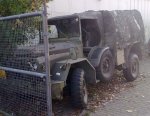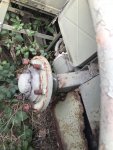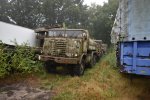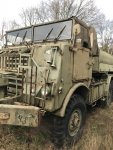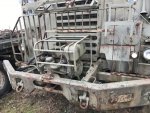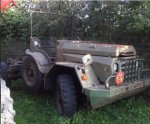I tried but lost out on an auction with two DAF YA126s, both 1957
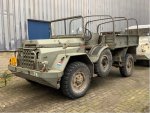
For this green one, my bid of 560 EUR (630 $) was forever the highest bit. Then the auction day came, and I lost out very quickly. Sad but glad about that, my spouse would have killed me if I would have bought it, and I actually did not have the money.
This auction has a very nice way of doing this. Lots close at a certain time, but after every bidding, you get 3 minutes to overbid. So the sale closed at four PM, but at 15:59, some made a bid, and 250 seconds later, another, and another, etc unil at 16:40, the bidding closed at 2,300 $.
To bad I did not have the money and my non-profit needs it more than my hobby, its not a bad price.
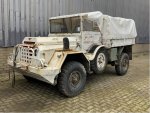
This one went, also after closing time, for 2,150$.
The interesting thing is that the green DAF has as total allowable weight 4,450 kg on the registration papers, 3,450 kg own weight, and 1,000 kg loading capacity. That means you have to have a C license to drive it
The white one has 3,350 kg own empty weight and only 149 kg loading capacity on paper. So if you do not weight more than 149 kg, you can drive this version with only your B license.
The green one is normal army color, the white DAF is a former UN "blue helmets" MV which has been in combat zone's (probably Balkan).
In the European Union:
- B license is personal cars with a max train weight of 3,500 kg (with trailer up to an additional 750 kg total train weight) or small buses with up to 9 people, including the driver (8 passengers and one driver).
- C license is for cargo vehicles over 3,500 kg. This is NOT a CDL. With C, you can drive your heavy MV, RV or anything over 3,500 kg (with trailer 7,00 kg) as long as you do not do it as a professional cargo transporter. So a blacksmith with C license can transport his 10K kg work and install it without CDL, this is not considered cargo transport. However, if he hires a company to transport the same thing, the driver of the company has to have a CDL; they are commercially transporting cargo for third parties.
- D license is for people transport of 10 people and more, driver included.
- E license is for a trailer over 750 kg. In the old days, you got the E automatically, now you have to do a test for it as well.
Personally, I have a CDL for both C and D. Thanks to the EU harmonization rules, this is now mentioned on your normal driver's license as well through the addition of "code 95" after each category, and valid in all countries inside the EU.



